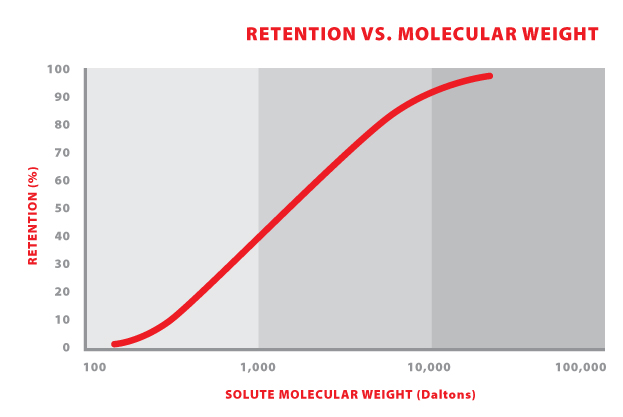Definition of Molecular Weight Cut Off
Molecular weight cut-off (MWCO) is a method of characterization used in filtration to describe pore size distribution and retention capabilities of membranes. It is defined as the lowest molecular weight (in Daltons) at which greater than 90% of a solute with a known molecular weight is retained by the membrane.
Dextran, polyethylene glycol, and proteins of various molecular weights are commonly used to rate the MWCO of membranes. For example, a membrane that can remove dissolved solids with molecular weights of 1,000+ has a molecular weight cutoff of 1,000. (see rejection vs. molecular mass curve below) Membranes with this particular MWCO would be suitable for applications in dye separation and antibiotic filtration for sterilization purposes.When choosing the appropriate molecular weight cut-off for specific applications, many factors must be considered including sample concentration, composition, molecular shape, and operating conditions such as temperature, pressure, and cross-flow velocity. Other variables regarding the flow of molecule passage must also be factored in. For example, linear molecules, high transmembrane pressure (TMP) and low sample concentration can increase molecule passage, while low temperature and membrane fouling can decrease molecule passage. It is also important to keep in mind that qualification methods for molecular weight are not always comparable, as they vary across manufacturers. Since there is no set industry standard for MWCO determination, there may be some limitations to this measurement technique. Therefore, it is advisable to select a molecular weight cut-off that is at least 2 times smaller than the molecular weight of the solute that is being retained.

CASE STUDY
questions? Fill out this form. We’ll contact you within 24 hours!
Applications
Resources
MEMBRANE RESOURCES
- Definition of a Membrane
- Membrane Materials: Organic vs. Inorganic
- Pressure-Driven Membrane Filtration Processes
- Concentration Polarization in Pressure-Driven Processes
- Degrees of Membrane Separation
- Flux Behavior in Membrane Processes
Module Configurations & Processes
-> View all membrane resourcesTUTORIALS









